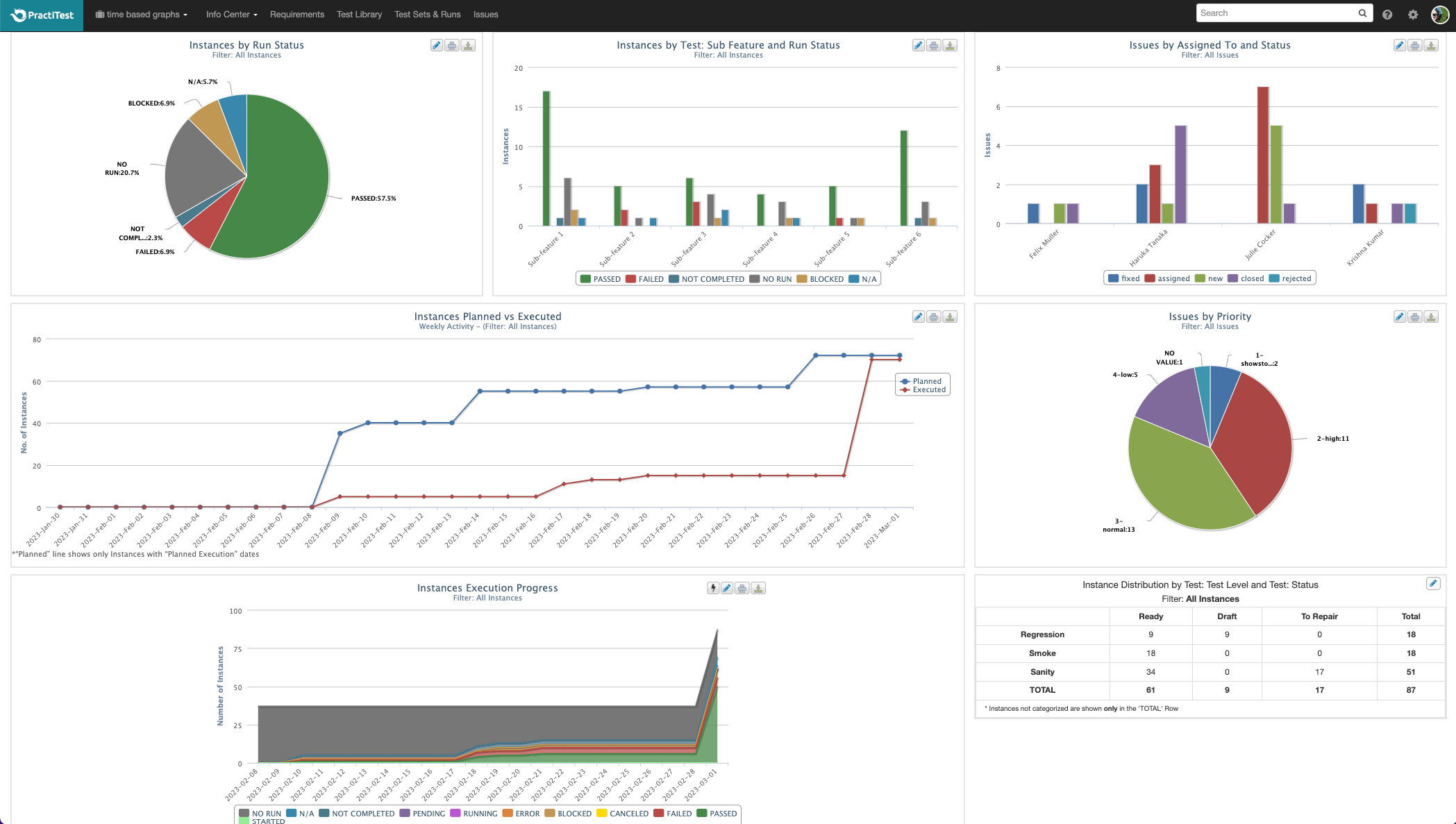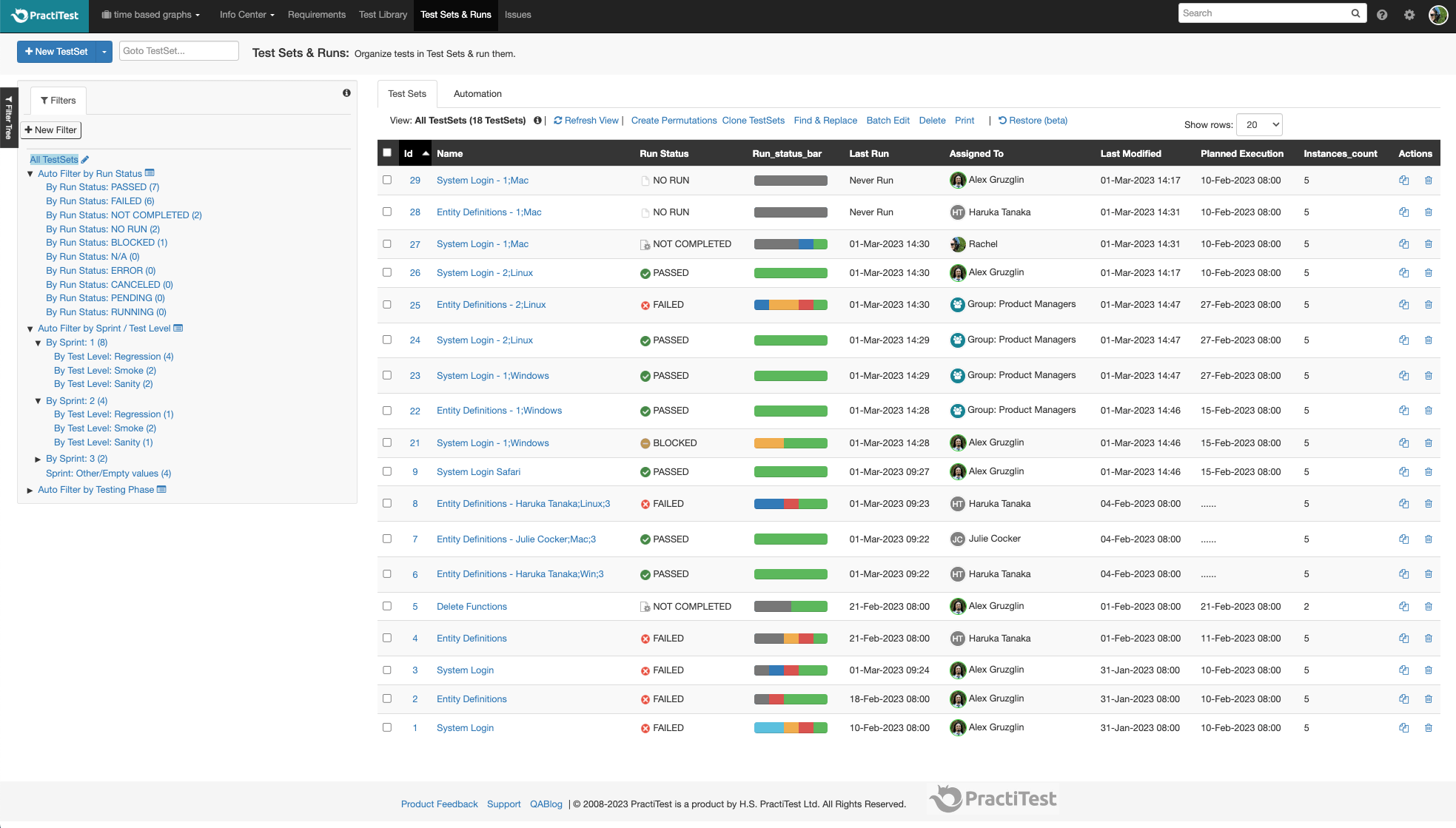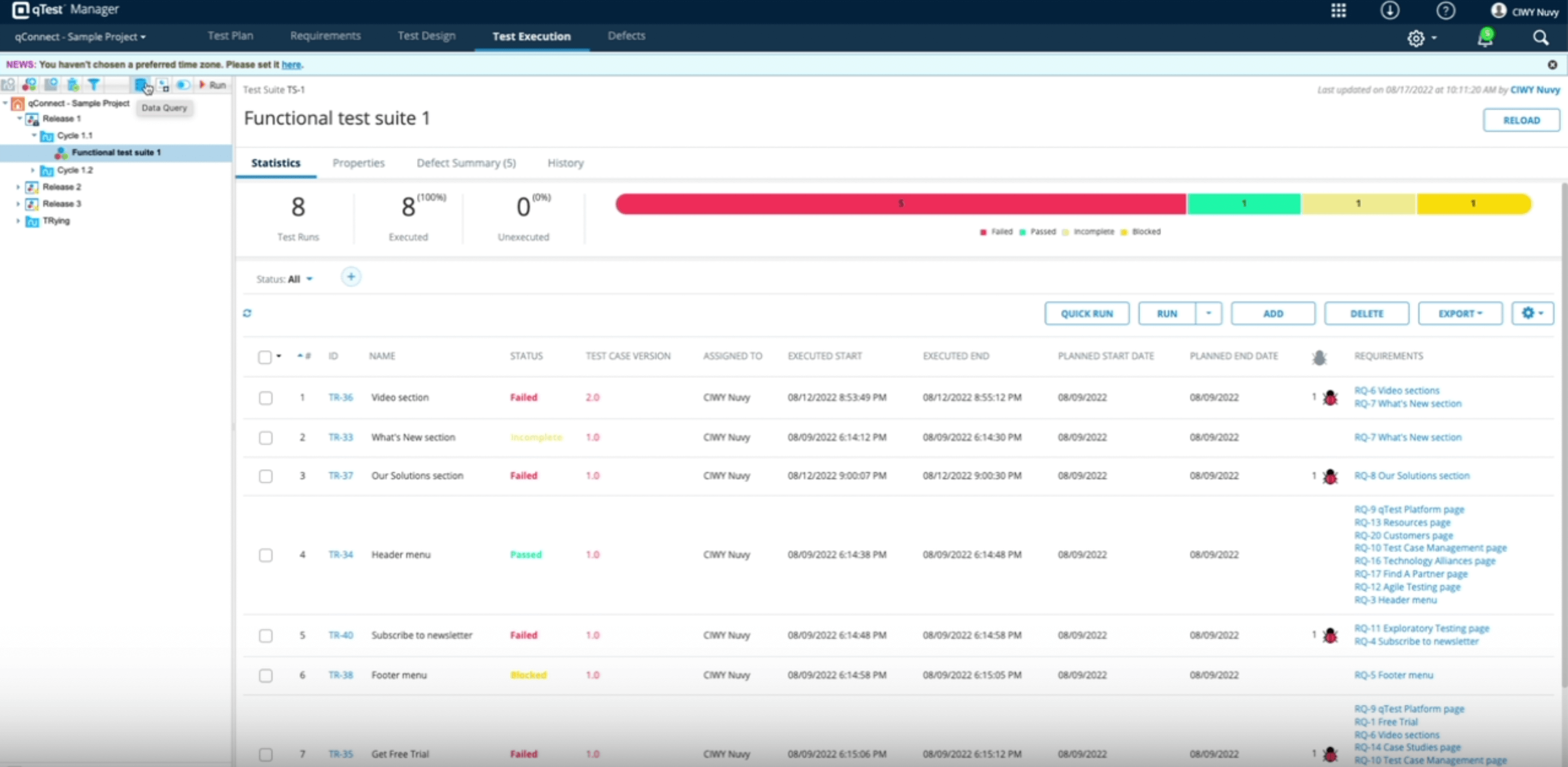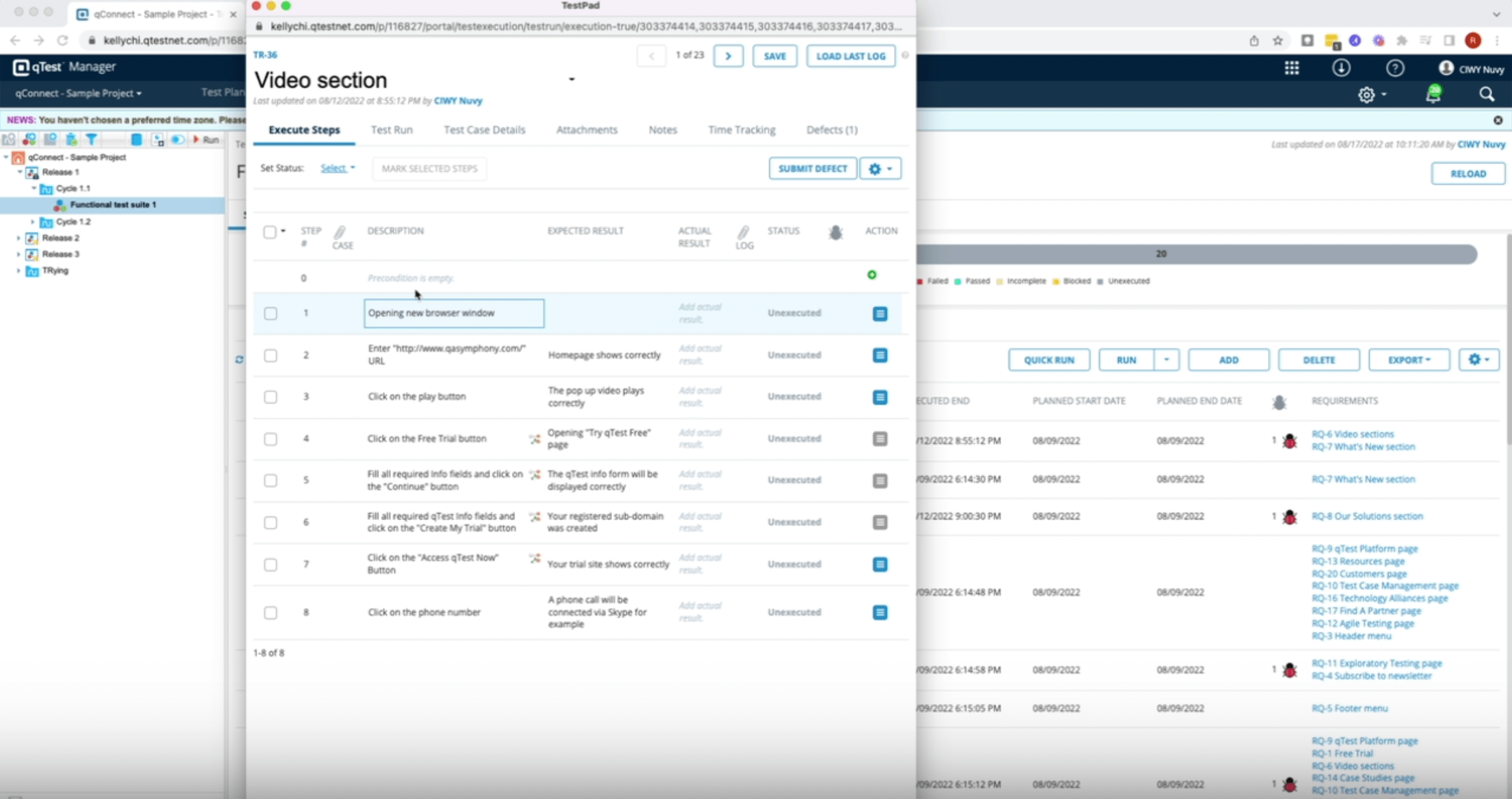PractiTest vs. qTest
When looking for a test management tool, there are many things to consider. We gathered the most important information about PractiTest and qTest to help you choose the right tool.
PractiTest vs. qTest At a Glance
Both PractiTest and qTest are Agile compatible test management tools that offer end-to-end coverage of the entire QA process: Requirements, Tests and Test Case Management, Issue Management and Reporting.
PractiTest is a QA management platform giving you end-to-end control of your entire testing operation so you can release quality software with confidence. By integrating with any bug tracker, project management, and automation tool, PractiTest provides a centralized hub for all QA information allowing you to make smarter and faster decisions.
qTest is a part of the Tricentis portfolio, providing you with a complete tool set for the different development phases. It is made of a few sub-tools, each one responsible for different aspects of test management.

“We evaluated several different test management platforms and chose PractiTest as our company standard. We are now consolidating our various test management systems into PractiTest.”
– Arthur Meloy, VP Site Reliability Engineering at NCR
How PractiTest and qTest Stack Up
The following comparison reviews the main features to take into account when considering which one will best fit your QA needs.
Ready to unlock the full potential of PractiTest? Click the button below to start your exclusive 14-day trial and experience the benefits firsthand.

| PractiTest | qTest | |||||||||||||||||||||||||||||||||
|---|---|---|---|---|---|---|---|---|---|---|---|---|---|---|---|---|---|---|---|---|---|---|---|---|---|---|---|---|---|---|---|---|---|---|
| Requirement and User Stories Management | ||||||||||||||||||||||||||||||||||
|
||||||||||||||||||||||||||||||||||
| Test case management | ||||||||||||||||||||||||||||||||||
|
||||||||||||||||||||||||||||||||||
| Test Sets and Execution Management | ||||||||||||||||||||||||||||||||||
|
||||||||||||||||||||||||||||||||||
| Issue management | ||||||||||||||||||||||||||||||||||
|
||||||||||||||||||||||||||||||||||
| Time-Based Testing Iterations Management | ||||||||||||||||||||||||||||||||||
|
||||||||||||||||||||||||||||||||||
| Integrations | ||||||||||||||||||||||||||||||||||
|
||||||||||||||||||||||||||||||||||
| Customization | ||||||||||||||||||||||||||||||||||
|
||||||||||||||||||||||||||||||||||
| Reporting | ||||||||||||||||||||||||||||||||||
|
||||||||||||||||||||||||||||||||||
| AI-Powered Test Management | ||||||||||||||||||||||||||||||||||
|
||||||||||||||||||||||||||||||||||
| Additional Features | ||||||||||||||||||||||||||||||||||
|
||||||||||||||||||||||||||||||||||
| Security and Certifications | ||||||||||||||||||||||||||||||||||
|
||||||||||||||||||||||||||||||||||
| Service and Support | ||||||||||||||||||||||||||||||||||
|
||||||||||||||||||||||||||||||||||


Pros and Cons

Pros:
- End-to-end solution - full traceability between requirements, tests, and issues
- AI-powered features
- Unique hierarchical filter tree to organize all project information and data
- 2-way integration with Jira and other tools, multiple ways to integrate automation
- Advanced customizable dashboards and reports
- Security compliance - SOC type II and ISO 27001
- Free and responsive customer support
Cons:
- Outdated UI

Pros:
- Part of a fuller applications portfolio
- App for tablets
- A dedicated separate module for automation execution
- Approval mechanism for tests
Cons:
- Paid support
- Separate tabs for the different modules
- Test run status is not automatically updated according to steps’ status
- Dashboards cannot be filtered according to custom fields
- Automation and manual results are in some cases separated and cannot be presented together in a sufficient way
- Insufficient Jira integration capabilities
- Limited SSO options
Pricing

- Team - $49 per user/month
- Corporate - Contact us
- Additional free read-only users with comments

qTest pro (SaaS only):
- Starts at $1,000 per named user.
Doesn not include: Customizable reports and dashboards, qTest scenario (BDD for Jira), qTest Launch (automation framework), qTest Pulse, Onboarding.
qTest Enterprise (SaaS and on-prem):
- Starts at $2,900 per concurrent user.
Does not include: Onboarding.
Bottom Line
Both PractiTest and qTest are Agile compatible Test Management tools that offer end-to-end coverage of the entire QA process: Requirements, Tests and Test Case management, Issue Management and Reporting.
While qTest offers both cloud and server (in-house) hosting for its software, PractiTest is a SaaS-only solution.
qTest’s different modules work in different tabs and are not all available in all pricing plans. With PractiTest, all modules are in the same location, helping users concentrate on the actual work. Both PractiTest pricing plans are transparent and include all modules.
PractiTest offers an internal kanban task board that helps manage your projects in a more efficient manner.
PractiTest’s unique hierarchical filters make it possible to define parameters for test cases and test sets, avoid duplicate bugs, and offer a smarter way to easily manage all project information.
So who is better?
When it comes to ROI and comparing the cost vs. benefits, qTest is much more expensive and doesn’t have any major additional takeaways. PractiTest costs less and brings more value to test managers and the development process. Add PractiTest’s all-time-available free-of-charge support and PractiTest takes the lead
FAQ
Is qTest a Test Management tool?
Yes, it is. It is made of several apps that together help users manage their testing.
What is the difference between test management and Jira?
Jira is a bug-tracking agile project management tool for developers to manage their tickets and workflow. Test Management is used to manage the testing of a product: plan testing activities, track progress, report the status of quality assurance activities, and more.
Many test management tools have a built-in integration with Jira to allow better communications between development and QA team members and to enable a seamless workflow.
What are the uses of PractiTest?
PractiTest is an end-to-end QA management platform, used by QA teams in all industries. With PractiTest you can run, track, and monitor your testing to ensure quality software and timely delivery.
What are you waiting for?
Want to learn more?
Set a meeting with one of our representatives to see how PractiTest can help improve your QA process.



